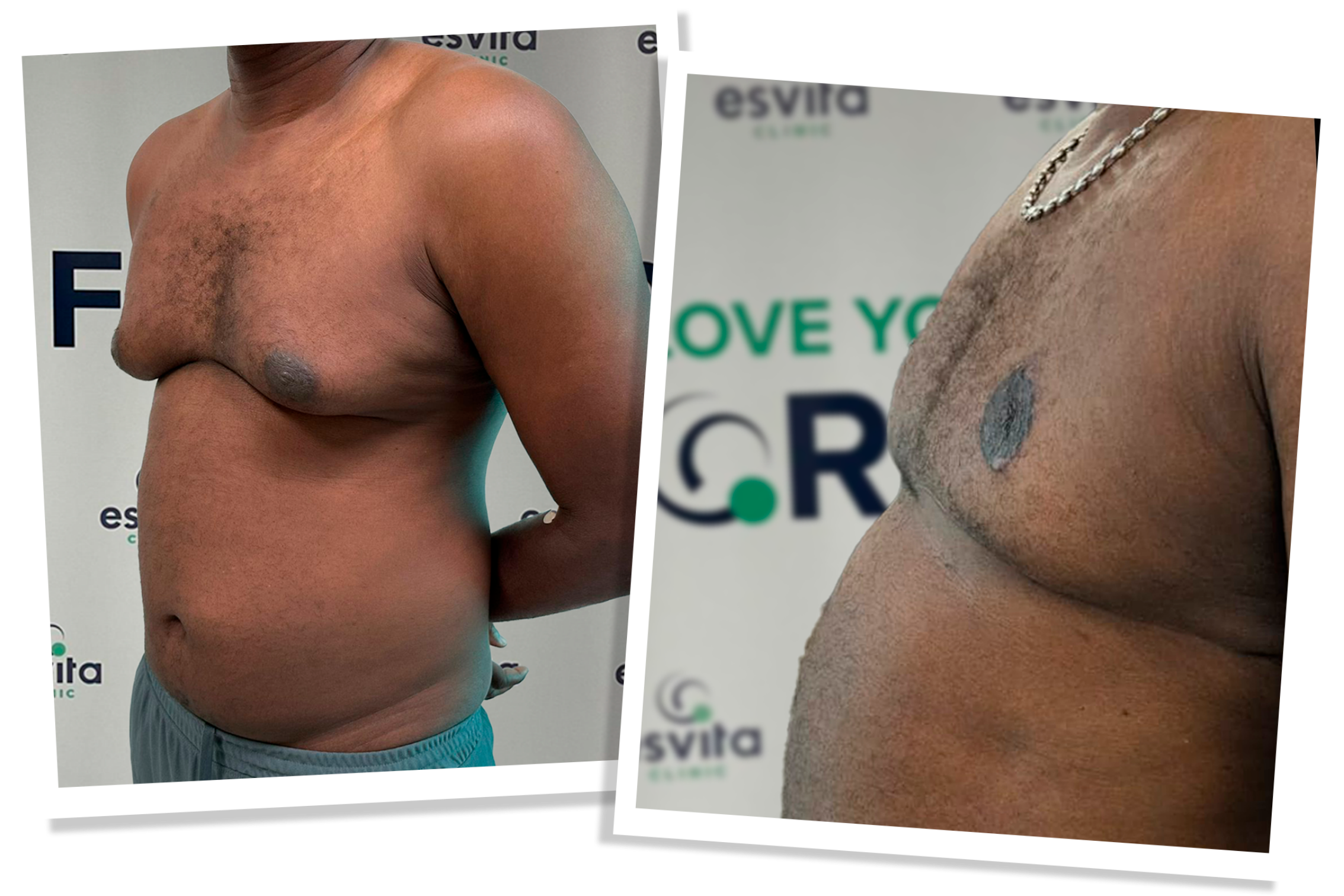
Gynecomastia surgery, also known as male breast reduction, is a procedure designed to remove excess breast tissue, fat, and skin in men who experience enlarged breasts due to hormonal imbalances, weight fluctuations, genetics, or medication side effects. While gynecomastia is a common condition, it can cause self-consciousness and discomfort, making surgery a popular option for those seeking a flatter, more masculine chest contour.
Maintain a stable weight and follow fasting instructions the night before the procedure.

Gynecomastia surgery, or male breast reduction, is a cosmetic procedure designed to reduce excess breast tissue, fat, and skin in men who experience enlarged breasts. This condition, known as gynecomastia, can be caused by hormonal imbalances, genetics, obesity, medication side effects, or certain medical conditions. While not harmful, gynecomastia can lead to self-consciousness and discomfort, making surgery a popular solution for achieving a flatter, more sculpted chest.
The procedure typically involves liposuction to remove excess fat and, in more severe cases, surgical excision to remove glandular breast tissue or excess skin. Recovery time varies, but most patients can return to light activities within a week, with full healing taking a few months. With proper post-surgery care and lifestyle maintenance, the results of gynecomastia surgery are often long-lasting and confidence-boosting.
Gynecomastia is caused by an imbalance between estrogen and testosterone levels, leading to excess breast tissue growth in men. This condition can develop at any age and is often linked to hormonal changes during puberty, aging, obesity, or underlying medical conditions. Other common causes include steroid use, certain medications (such as antidepressants or heart medications), excessive alcohol consumption, and drug use (such as marijuana or anabolic steroids). In some cases, genetics also play a role in its development.
The most noticeable symptom of gynecomastia is enlarged, swollen breast tissue, which may feel firm or tender to the touch. Some individuals experience pain or discomfort, while others may notice asymmetry in breast size. In severe cases, excess skin and sagging can occur, making the chest appear more feminine in shape. If the condition persists despite weight loss and lifestyle changes, consulting a medical professional or plastic surgeon can help determine whether surgical intervention is the best option for restoring a flatter, more masculine chest.
Gynecomastia surgery is designed to permanently reduce excess breast tissue, fat, and skin, restoring a flatter, firmer chest contour. Depending on the severity of the condition, the procedure may involve liposuction, excision, or a combination of both.
The procedure is performed under local or general anesthesia and typically lasts one to two hours. After surgery, patients wear a compression garment to minimize swelling and support healing. Most individuals can return to light activities within a week, with full results becoming visible in a few months as the chest settles into its new shape.
Gynecomastia surgery is a minimally invasive procedure designed to remove excess breast tissue, fat, and skin, creating a flatter, more masculine chest. The surgery is typically performed under local or general anesthesia and takes one to two hours, depending on the severity of the condition.
Once the tissue is removed, the incisions are carefully closed, and the patient is fitted with a compression garment to support healing and reduce swelling. Most patients can return to light activities within a few days, while full recovery takes about four to six weeks.
When it comes to gynecomastia surgery, the choice between liposuction and tissue excision depends on the composition of the enlarged breast tissue and the patient’s desired outcome.
In many cases, a combination of both liposuction and excision is used to achieve the most natural and sculpted chest appearance. A consultation with a board-certified plastic surgeon helps determine which approach is best based on individual anatomy and treatment goals.
The results of gynecomastia surgery are typically long-lasting, provided that patients maintain a stable weight and a healthy lifestyle. Once the excess fat and glandular tissue are removed, they do not usually return unless triggered by factors like significant weight gain, hormonal imbalances, or medication side effects.
To preserve the flatter, more sculpted chest, patients should adopt a balanced diet, regular exercise routine, and avoid substances linked to gynecomastia, such as steroids, excessive alcohol, and certain medications. Scar care is also important—keeping the incision sites moisturized, avoiding direct sun exposure, and using silicone-based scar treatments can help minimize visibility over time.
Routine medical check-ups ensure that hormone levels remain balanced, reducing the risk of recurrence. While the initial results are noticeable within a few months, the final contour fully develops within six months to a year, leaving most patients with a permanent, more masculine chest shape.



Gynecomastia surgery can significantly improve self-confidence by eliminating the discomfort of enlarged male breasts. Many men feel more at ease in social settings, the gym, or while wearing fitted clothing after achieving a flatter, more masculine chest.
Beyond the physical change, the procedure often brings emotional relief. Patients report feeling more confident, less anxious, and more willing to engage in activities they once avoided—leading to improved personal and professional quality of life.
Yes, gynecomastia surgery is generally safe when performed by a board-certified plastic surgeon. Like any surgery, there are risks, including swelling, bruising, infection, or temporary numbness, but serious complications are rare. Following post-operative care instructions helps ensure a smooth recovery.
Most patients can return to light work within 3 to 7 days, depending on the type of job and individual healing speed. Those with physically demanding jobs may need 2 to 4 weeks before resuming full activity.
Scarring is minimal, as incisions are usually made around the areola or in the natural chest folds. Over time, with proper scar care, scars tend to fade significantly and become barely noticeable.
Most insurance companies do not cover gynecomastia surgery unless it is deemed medically necessary, such as cases related to hormonal disorders or pain. Patients should check with their insurance provider and discuss financing options if needed.



Gynecomastia surgery typically delivers permanent results, as the excess glandular tissue and fat removed do not grow back. Once removed, the chest maintains a flatter, firmer appearance, boosting long-term confidence and comfort.
To preserve results, it’s important to maintain a stable weight and balanced hormone levels. Significant weight gain, hormonal changes, certain medications, or steroid use can lead to recurrence. A healthy lifestyle, regular exercise, and avoiding hormone-disrupting substances help ensure lasting outcomes.

Contact with our experts and learn about your options! Or fill the form right side and we will call you
